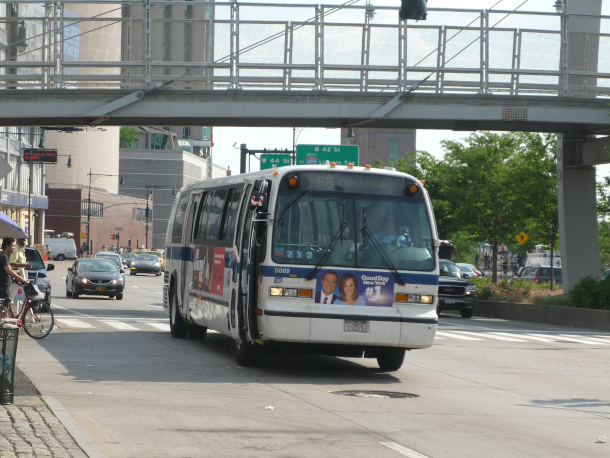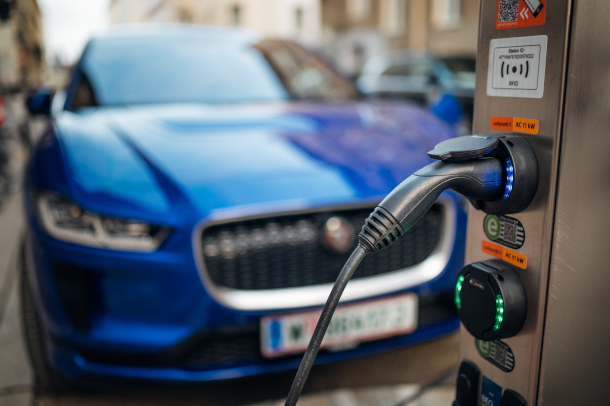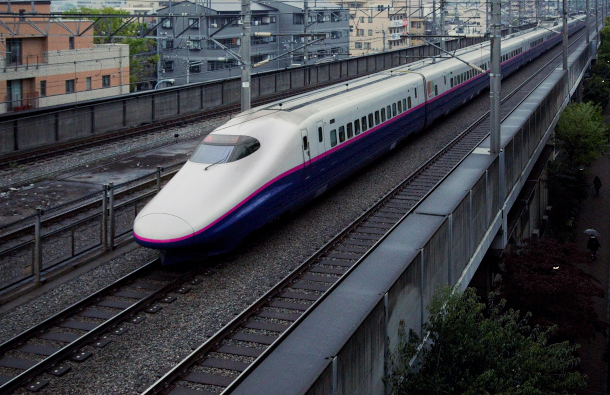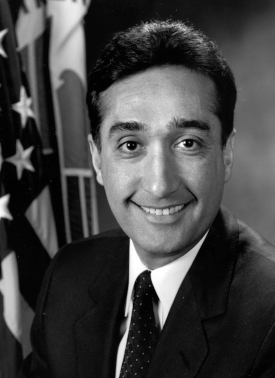Modernizing Mobility
Air Date: Week of February 12, 2021

Public transportation is essential for equitable mobility, but according to the American Public Transportation Association, 45% of Americans do not have access to public transportation. (Photo: Jason Lawrence, Flickr, CC BY 2.0)
In the United States transportation infrastructure has fallen deep into disrepair with $2 trillion of deferred maintenance costs. President Joe Biden is seeking to modernize mobility infrastructure in a way that supports the broader overall goal of net zero carbon emissions by 2050. Henry Cisneros, the former mayor of San Antonio who served in the Clinton Administration as Secretary of Housing and Urban Development, joins Host Steve Curwood to talk about what a massive transportation transition means for America's economy, equity and health.
Transcript
BASCOMB: It’s Living on Earth, I’m Bobby Bascomb
CURWOOD: And I’m Steve Curwood.
Back in 2007 as the evening rush hour was getting underway in downtown Minneapolis, a bridge carrying highway I-35 over the Mississippi River suddenly collapsed. More a dozen people plunged to their deaths and nearly a hundred and fifty more were injured. That bridge collapse is a prime example of the nearly $2 trillion dollars worth of deferred maintenance and other broken parts of America’s infrastructure that President Biden has pledged to “build back better.” Not only is transportation a major part of infrastructure it is also linked to a quarter of US global warming pollution. So, Mr. Biden seeks to modernize mobility and infrastructure with a policy of getting the US to net zero carbon emissions by 2050, a goal that will take much longer to achieve than a single presidential term. Henry Cisneros is a former mayor of San Antonio who served in the Clinton Administration as secretary of housing and urban development. He is presently a tri chair of Connect SA, a non-profit that advocates for a $1.3 billion mobility infrastructure plan for the San Antonio-Austin Texas region. Mr. Secretary, Welcome to Living on Earth!
CISNEROS: Thank you very much.
CURWOOD: So when it comes to transportation projects, I don't know if they're forever, but they certainly live on for generations. And Joe Biden has just proposed a $2 trillion plan to work with infrastructure, address climate, and there's a huge transportation transition he's calling for. How big a deal is this, do you think?
CISNEROS: Well, I think it's a very, very substantial initiative. First of all, the size of the infrastructure package overall, is designed to really make a difference on the $2 trillion shortfall of infrastructure that the American Council on Civil Engineering says, the country suffers. Two trillion dollars of inadequate, unrepaired just needed infrastructure in many, many realms of American life. The transportation piece is always one of the larger, and that's to be expected. A lot of infrastructure is expensive it relates to streets, city streets, and highways, it relates to mass transit, everything from buses, to rail, and increasingly new mediums like mobility on demand and transit for disabled persons. It also is bridges, and tunnels and airports and seaports, all of those are transportation related. So transportation infrastructure is very important and some people might say ell, you know, there are other important things in our lives, like health or education clearly are wages and economics. But I think it's clear that transportation, which we might call more broadly, mobility is as fundamental to the life of a city or people as any of the other things that I've mentioned because it makes all of those possible, the trip to work, the trip to school, the trip to medical care, in all forms. It also has a massive impact on the physical layout, land use policies, transit oriented development in our cities, and communities and it also impacts our climate. We know that if we had more mass transit and fewer cars on the road we would have less emissions and many of our cities that are in non attainment on air quality, would have that problem addressed. So while it's easy to dismiss transportation it really is fundamental.
CURWOOD: Now, the Federal Highway Trust Fund finances most spending on highways and even some transit, but the revenues from the trust fund come from gas and diesel taxes. I think that tax hasn't been updated since what 1993, or something like that. The country's current highway law is about to expire in September, and new transportation legislation is going to be enacted. So what are some of the key points of action, the Biden ministration, should incorporate in this bill in order to work towards an effective transportation transition?

The Biden Administration transportation infrastructure plan calls for 500,000 new EV plugs across the U.S. by the end of this decade. (Photo: Ivan Radic, Flickr, CC BY 2.0)
CISNEROS: Well, I think there's a number of key points one of them is the adequacy of the system, we have tended in the past, to try to plan transportation from the top down the highway fund or the rail fund, and just abide by the designs created in the silos of the cabinet agencies in Washington instead of really relating to what is needed across the country. It's time to inquire of local officials across America, "What are your needs? Has the pandemic changed those needs? How do they relate to your long term economic development?" So bottom up planning of our infrastructure is one thing that I think we need to do differently than we have in the past. Another is the application of technologies. We're now living with new technologies that were not existing, when much of the present infrastructure came into being. And that means everything from creating sensors in roads to address congested and direct people to less congested routes, for example, computer applications to create mobility on demand in the public sector, which means Uber and Lyft type systems but that arrive at people's doors, and then link them into the public transit system and they pay the same fares as they would in public transit because these are part of an integrated transit system, we're seeing those now being tried. And then just around the corner are autonomous vehicles to be used in mass transit. So let's leave ourselves open to the most advanced technologies. The third, I think, would be that we have to find adequate funding for all of this, as you were suggesting, in your question. So yes, the gas tax is a part of this but there will come a day when the gas tax actually is less reliable as a source of funding because we're moving to electric vehicles, and there'll be less gas guzzlers on the streets. So we'll have to think in terms of new sources that are needed to make these investments in our transportation infrastructure.
CURWOOD: So the President has talked a lot about jobs. And did I say that he's talked about jobs? And has he mentioned jobs? This seems to be the White House mantra these days. So what are some of the biggest jobs that could be created through the transportation transition? Do you think?
CISNEROS: Well, it's not just transportation, but it's other forms of infrastructure as well. It's the power system it's the water system. It's what's called social infrastructure, which is new kinds of social offerings like broadband and communications, the fact that we need to hospitals and clinics. The jobs are first of all, we have to design a lot, to build a lot so there's a lot of jobs to be had, in the anticipation, the lead up the preparation of a massive national infrastructure plan. The second is the actual construction, we need people who can build things. We need people who have the construction, crafts and skills and technological skills, to build things in the new iteration of infrastructure, which involves new technologies like integrating computers and communications into everything from roadways, to power grid, etc. And then thirdly, there's the operations of all of these things for the long run, where we need people who are more computer literate, and can make repairs to these complex systems. So the one thing about infrastructure is the jobs cannot be exported. These are not enterprises that could be sent to China or Latin America. These are jobs right in our backyard for our people in our communities. And the people who have been employed are potentially a new generation of talent. And people who have been on the margins of the economy before who now are brought in because they're provided the skills through training. So there's a lot a lot of benefits on the jobs front and on the income front and on the equity front.
CURWOOD: Mr. Cisneros, you've talked about using a carbon tax as a way to help finance this $2 trillion infrastructure plan. How effective Do you think the carbon tax would be?
CISNEROS: Well, it's obviously a controversial and we haven't actually utilized the carbon tax before. The plus side of a carbon tax is that it serves as a disincentive for the use of traditional carbon, fossil fuel based fuels, that is huge! If people recognize that their future is better served by utilizing electric vehicles and and other sources of renewables that's better for the country. So that's the major plus side. And then the second is revenues that are generated, can be used for advancing purposes in new technologies. Downside is it’s hard to pass, it’s new people are not attuned yet to it and it's natural to oppose anything that has the effect of changing the internal structure of an industry, and so there will be opposition to it. That is the hard part.

Japan’s high-speed trains, otherwise known as shinkansen, run at 199 mp/h (320 km/hr) and connect the largest metropolitan areas throughout the country. The United States has only one federally supported high speed rail in the works, the California High Speed Rail. (Photo: Tokyoform, Flickr, CC BY-NC-ND 2.0)
CURWOOD: So what are the health benefits of a transportation infrastructure $2 trillion project?
CISNEROS: I saw a graphic the other day that showed a bus on the street and next to it in the next lane, 60 cars. The point was, it would take 60 cars to provide transportation for the people that would otherwise be on that advanced rapid transit bus with multiple cars. So the first health benefit is to our air emissions, our air quality. Many cities are living with attainment issues where literally the air is dangerous for people to breathe because principally of automobile emissions. So one of the major dimensions of using renewables for fuels is they don't pose that health problem of carbon emissions. The second I would say is, to the degree that we can provide more equitable transportation, we can get people to health clinics and health centers, places where they can anticipate diseases that are not yet acute before they get their mothers that can take little children who don't have another means of transportation. So to the degree we create a truly equitable, far reaching, integrated transit mobility system, we create a more equitable society.
CURWOOD: One of the projects that's been mentioned in all of this is that to start to bring more high speed rail to the United States, and we've seen past efforts to do high speed rail, run into changing administrations. I'm thinking of what's been happening in California for example. How do you get a project like high speed rail going and keep it going, even if the administrations change?

Henry Cisneros is the former mayor of San Antonio and was the Secretary of Housing and Urban Development in the Clinton Administration. (Photo: Department of Housing and Urban Development, Wikimedia Commons, Public Domain)
CISNEROS: Well, first of all, let me just say with respect to high speed rail, I am a big fan. It really brings a country together being able to give people a means of transportation rapidly and safely across the country. The United States effectively has not one single mile of bonafide high speed rail. We have some trains that run a little faster on certain routes for short periods of time. But the northeast corridor is an example that is not high speed rail, not compared to what the Japanese have had since the 1960s. The Shinkansen, which runs 150 miles an hour, and they have 1500 miles of it, or what exists in China, where they have trains running 200 miles an hour, and they have 6000 miles of it. So we're way behind and we suffer from not having it available. If people could take a train like that between New York and Washington just to pick one location. They would take people off the highways, they would decongest the airways between those places, or Los Angeles and San Francisco or Los Angeles and Las Vegas, or Miami and Orlando, Tampa, or the Chicagoland area and other Midwest cities there, north to Milwaukee, East Indianapolis, this would transform the country. So in an era when the precious cargo was grain, and food and petroleum, we had canals, like the St. Lawrence Seaway, like the Erie Canal. Today, when the cargo the precious cargo is human ability to sit down with others, to negotiate, to create, to collaborate, we want to move people.
CURWOOD: Henry Cisneros is the former mayor of San Antonio, Texas and served as Secretary of Housing and Urban Development under President Bill Clinton. Mr. Secretary, thanks so much for taking the time with me today.
CISNEROS: Thank you.
Links
Learn More about the Biden-Harris Administration’s transition plans
NY Post | “Pete Buttigieg to Press for Infrastructure Plan During Senate Confirmation Hearing”
San Antonio Business Journal | “Cisneros: ConnectSA Ready to Roll with Landmark Mobility Plan”
Living on Earth wants to hear from you!
Living on Earth
62 Calef Highway, Suite 212
Lee, NH 03861
Telephone: 617-287-4121
E-mail: comments@loe.org
Newsletter [Click here]
Donate to Living on Earth!
Living on Earth is an independent media program and relies entirely on contributions from listeners and institutions supporting public service. Please donate now to preserve an independent environmental voice.
NewsletterLiving on Earth offers a weekly delivery of the show's rundown to your mailbox. Sign up for our newsletter today!
 Sailors For The Sea: Be the change you want to sea.
Sailors For The Sea: Be the change you want to sea.
 The Grantham Foundation for the Protection of the Environment: Committed to protecting and improving the health of the global environment.
The Grantham Foundation for the Protection of the Environment: Committed to protecting and improving the health of the global environment.
 Contribute to Living on Earth and receive, as our gift to you, an archival print of one of Mark Seth Lender's extraordinary wildlife photographs. Follow the link to see Mark's current collection of photographs.
Contribute to Living on Earth and receive, as our gift to you, an archival print of one of Mark Seth Lender's extraordinary wildlife photographs. Follow the link to see Mark's current collection of photographs.
 Buy a signed copy of Mark Seth Lender's book Smeagull the Seagull & support Living on Earth
Buy a signed copy of Mark Seth Lender's book Smeagull the Seagull & support Living on Earth

